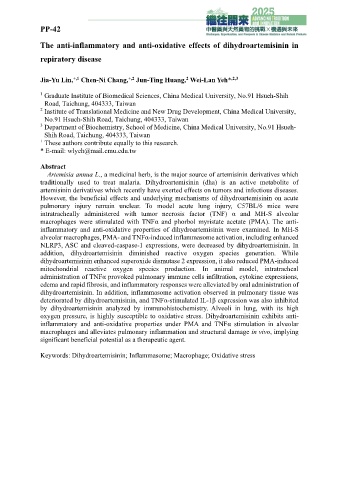Page 224 - 2025中醫藥與天然藥物聯合學術研討會-中醫藥與天然藥物的挑戰X機遇與未來大會手冊
P. 224
PP-42
The anti-inflammatory and anti-oxidative effects of dihydroartemisinin in
repiratory disease
2
+,1
+,2
Jia-Yu Lin, Chen-Ni Chang, Jun-Ting Huang, Wei-Lan Yeh* ,2,3
1 Graduate Institute of Biomedical Sciences, China Medical University, No.91 Hsueh-Shih
Road, Taichung, 404333, Taiwan
2 Institute of Translational Medicine and New Drug Development, China Medical University,
No.91 Hsueh-Shih Road, Taichung, 404333, Taiwan
3 Department of Biochemistry, School of Medicine, China Medical University, No.91 Hsueh-
Shih Road, Taichung, 404333, Taiwan
+
These authors contribute equally to this research.
* E-mail: wlyeh@mail.cmu.edu.tw
Abstract
Artemisia annua L., a medicinal herb, is the major source of artemisinin derivatives which
traditionally used to treat malaria. Dihydroartemisinin (dha) is an active metabolite of
artemisinin derivatives which recently have exerted effects on tumors and infectious diseases.
However, the beneficial effects and underlying mechanisms of dihydroartemisinin on acute
pulmonary injury remain unclear. To model acute lung injury, C57BL/6 mice were
intratracheally administered with tumor necrosis factor (TNF) α and MH-S alveolar
macrophages were stimulated with TNFα and phorbol myristate acetate (PMA). The anti-
inflammatory and anti-oxidative properties of dihydroartemisinin were examined. In MH-S
alveolar macrophages, PMA- and TNFα-induced inflammasome activation, including enhanced
NLRP3, ASC and cleaved-caspase-1 expressions, were decreased by dihydroartemisinin. In
addition, dihydroartemisinin diminished reactive oxygen species generation. While
dihydroartemisinin enhanced superoxide dismutase 2 expression, it also reduced PMA-induced
mitochondrial reactive oxygen species production. In animal model, intratracheal
administration of TNFα provoked pulmonary immune cells infiltration, cytokine expressions,
edema and rapid fibrosis, and inflammatory responses were alleviated by oral administration of
dihydroartemisinin. In addition, inflammasome activation observed in pulmonary tissue was
deteriorated by dihydroartemisinin, and TNFα-stimulated IL-1β expression was also inhibited
by dihydroartemisinin analyzed by immunohistochemistry. Alveoli in lung, with its high
oxygen pressure, is highly susceptible to oxidative stress. Dihydroartemisinin exhibits anti-
inflammatory and anti-oxidative properties under PMA and TNFα stimulation in alveolar
macrophages and alleviates pulmonary inflammation and structural damage in vivo, implying
significant beneficial potential as a therapeutic agent.
Keywords: Dihydroartemisinin; Inflammasome; Macrophage; Oxidative stress

